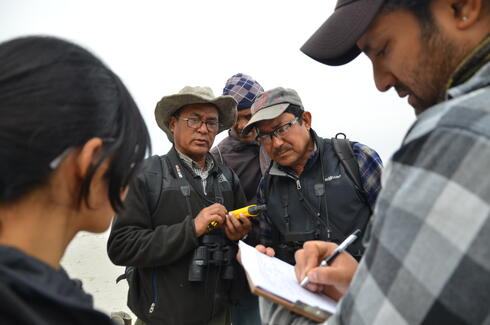Next is the line transect survey, which is a method used to record prey population density while walking a straight line referred to as a “transect”. Harka takes out his GPS unit to locate the start and end positions for the transect. On this day, our line transects traverse through a riverine habitat and will require team members to walk about a mile in a straight line; doing their best to keep as quiet as they can and not disturb their surroundings. Sabita and Prakhyat volunteer for the task and see a group of hog deer, a prey species for tigers. They quickly take note of this sighting including the number and, if possible, the sex of the animals. Prakhyat uses a range finder to measure the distance between themselves and the hog deer, while Sabita takes note of the direction in which the animal was spotted using a compass.
Bishnu explains that for any forest to house a healthy population of tigers, good habitat and abundance of prey are the two key criteria. The line transect survey data would eventually help the research team to determine prey abundance in the area so that corresponding interventions such management of grassland habitats, wetland creation, etc. can be planned effectively.
Both the line transect and occupancy surveys take close to four hours to complete and it is nearly sun-down by the time the team is ready to call it a day. It is time to head back to camp.
It is already 7:15 pm by the time the team returns to camp, slightly exhausted but happy with the good start to their 20-day expedition. Almost immediately, a fire is lit and dinner gets cooking while Bishnu opens his book of stories to share with the team...a ritual by the fire he follows almost every night at camp.
The story he tells tonight - his personal favorite - dates back to the early 80s when he and Harka used to monitor tigers through the use of radio collars. Back then, bait was used to attract the tigers and, on this particular occasion, Bishnu and Harka had found that a tiger had apparently taken the bait. Walking cautiously to identify the actual location of the site, they were surprised to come across two tiger cubs gnawing on the carcass. In seconds, they heard a loud roar and saw a tiger leap at them. Almost instinctively, Bishnu and Harka darted in opposite directions quite certain that this would be their last expedition together and that the tiger would get at least one of them.
“Our happiness knew no bounds to find that we had survived this close encounter. Come to think of it, it was the cubs that saved us. The mother was only following its protective instincts and chose to stay back with her cubs,” recalled Bishnu.
More stories continued on into the night before the team finally decided to head into their tents. Day would soon follow the night and Bishnu and his team would need to start out early again the next day, guided by the blessings of the Forest Goddess and urged on by a common passion for tigers.

